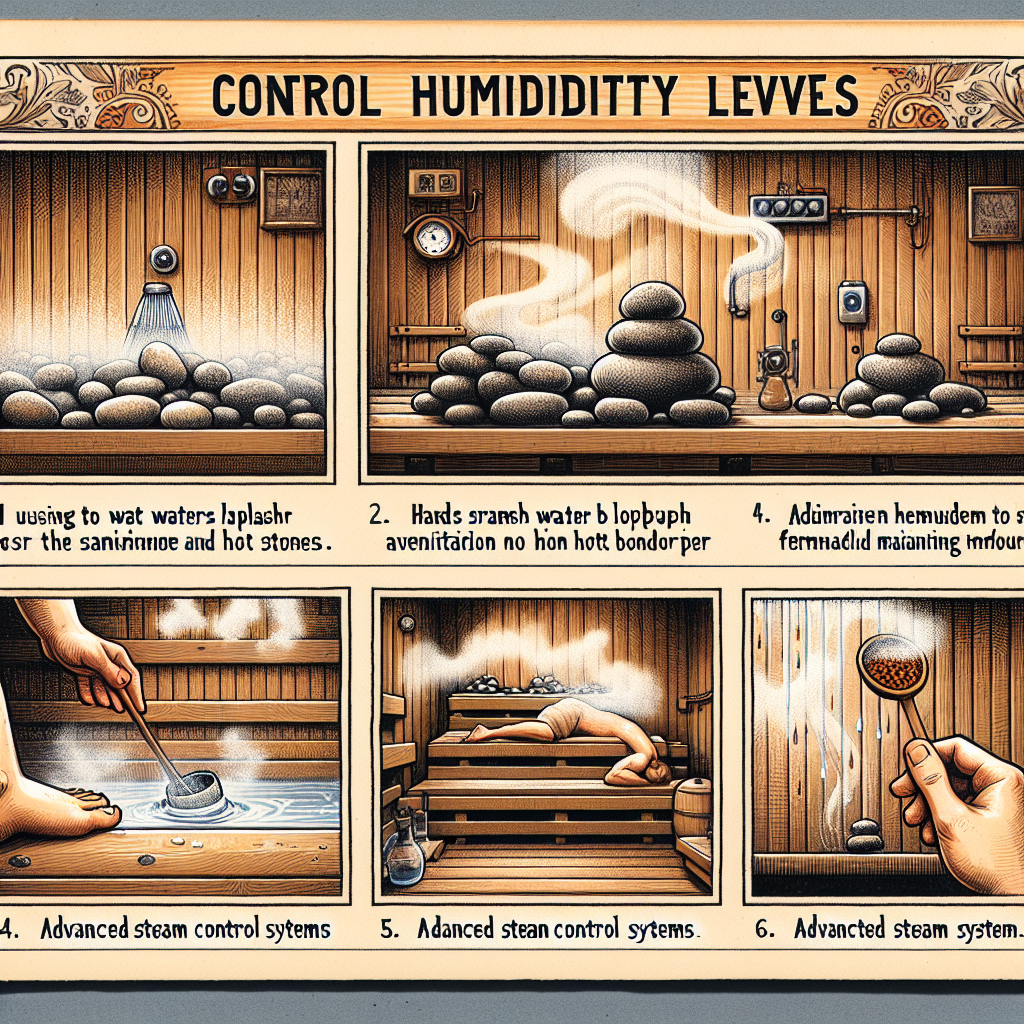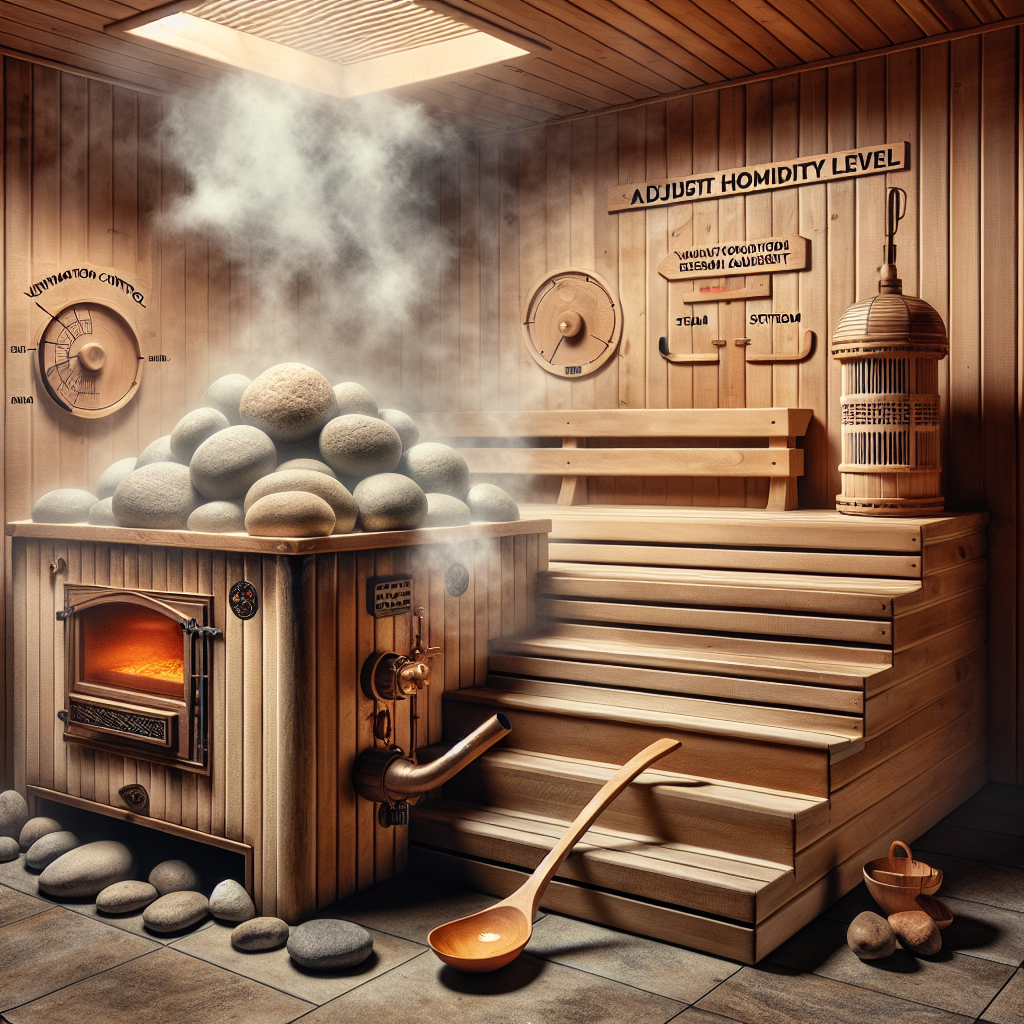So you’ve decided to indulge in a rejuvenating session in a traditional sauna, but now you’re curious about how to adjust the humidity levels to create the perfect environment for relaxation and detoxification. Well, fear not, because in this article, we will guide you through the simple yet effective methods of adjusting humidity levels in a traditional sauna. Whether you prefer a steamy oasis or a drier heat, we’ve got you covered. Get ready to embark on a soothing journey as we unveil the secrets to creating your own personal oasis of tranquility.
Understanding Humidity in a Traditional Sauna
Humidity plays a vital role in the overall sauna experience. It refers to the amount of moisture or water vapor present in the air, which can greatly affect your comfort and the effectiveness of your sauna session. In a traditional sauna, humidity levels are typically kept lower than in other types of saunas, such as steam saunas. It is important to understand the definition of humidity, the ideal humidity levels in a sauna, and the importance of controlling humidity.
Definition of Humidity
Humidity refers to the amount of water vapor present in the air. In a traditional sauna, humidity levels are typically lower, ranging from 10% to 20%. This low humidity is often preferred as it allows for a more intense and dry heat, which helps to cleanse the body and promotes sweating. In contrast, steam saunas have higher humidity levels, often exceeding 40%, as they rely on steam to create a more moist environment.
Ideal Humidity Levels in a Sauna
In a traditional sauna, the ideal humidity levels range between 10% and 20%. This low humidity allows for a dry heat, which is essential for a truly authentic sauna experience. With lower humidity, the air feels lighter and the heat penetrates more deeply into your body, promoting a greater release of toxins through sweat. Higher humidity levels can make the sauna experience feel damp and less enjoyable.
Importance of Controlling Humidity
Controlling humidity in a traditional sauna is crucial for several reasons. Firstly, it helps to create the desired sauna experience by maintaining a dry and intense heat. Secondly, it ensures your comfort during the session. Excessive humidity can make the air feel heavy and lead to discomfort. Lastly, controlling humidity also prevents issues such as excessive moisture and mold growth, which can lead to unpleasant odors and damage to the sauna structure.
Factors Affecting Humidity Levels
Several factors can affect humidity levels in a traditional sauna. Understanding these factors can help you maintain optimal humidity levels during your sauna sessions.
Water Pouring Techniques
Water pouring techniques play a significant role in adjusting humidity levels. Pouring small amounts of water onto the hot sauna rocks will create a burst of steam, temporarily increasing humidity levels. On the other hand, pouring larger amounts of water will create more steam and raise humidity levels for a longer period. The frequency and volume of water pouring can be adjusted to achieve the desired humidity level.
Bathing Habits
Bathing habits also influence humidity levels. When you enter the sauna with wet skin or hair, the moisture will evaporate and increase humidity. Therefore, it is recommended to dry off before entering the sauna to maintain the desired humidity levels.
Proper Ventilation
Proper ventilation is essential for controlling humidity in a traditional sauna. Ventilation systems help to circulate the air and remove excess moisture. Good ventilation also prevents the buildup of mold and mildew, ensuring a clean and healthy sauna environment.
Sauna Construction
The construction of the sauna itself can also affect humidity levels. The materials used, such as wood, and the insulation play a role in regulating humidity. High-quality materials and proper insulation can help maintain steady humidity levels and prevent moisture issues.

Methods to Increase Humidity
While traditional saunas are known for their low humidity, there may be instances when you want to increase humidity levels for a more intense experience. There are a few methods you can employ to increase humidity in a traditional sauna.
Adding Water to Sauna Rocks
The most common method to increase humidity in a traditional sauna is by adding water to the sauna rocks. This practice creates a burst of steam, raising the humidity temporarily. By pouring small amounts of water onto the rocks, you can achieve a slight increase in humidity. For a more intense and longer-lasting increase, larger amounts of water can be poured onto the rocks. Remember to pour water onto the rocks carefully to avoid burns and to maintain safety.
Using Sauna Steam Generators
Another method to increase humidity in a traditional sauna is by using sauna steam generators. These devices are designed to produce steam that can be released into the sauna. Sauna steam generators allow for precise control over humidity levels and can be a convenient option for those who prefer consistent steam production during their sauna sessions.
Methods to Decrease Humidity
If the humidity levels in a traditional sauna become too high, there are methods to decrease the humidity and restore the desired dry heat.
Adjusting Ventilation
Adjusting the ventilation system can help decrease humidity in a traditional sauna. By increasing airflow, excess moisture can be circulated and removed from the sauna. Opening doors or windows, if available, can also help to regulate humidity levels.
Reducing Water Pouring
Reducing the amount of water poured onto the sauna rocks can also help decrease humidity levels. By pouring less water, less steam is generated, leading to a drier heat and lower humidity.

Tips for Achieving Optimal Humidity Levels
Here are some helpful tips for achieving optimal humidity levels in a traditional sauna:
Monitoring Humidity with a Hygrometer
Using a hygrometer, a device that measures humidity levels, can be beneficial for monitoring and maintaining the desired humidity range. By regularly checking the humidity, you can adjust your sauna practices accordingly.
Maintaining Steady Temperature
Steady temperature control is crucial for maintaining optimal humidity levels. The heat source in the sauna should be regulated to ensure a consistent and comfortable temperature. Fluctuating temperatures can lead to changes in humidity levels.
Regular Sauna Maintenance
Regular sauna maintenance is essential for maintaining optimal humidity levels. Cleaning the sauna regularly and addressing any issues with insulation or ventilation will help prevent moisture buildup and mold growth, ensuring a healthy and enjoyable sauna experience.
Potential Health Risks of Improper Humidity Levels
Properly controlling humidity levels is not only important for the comfort and effectiveness of your sauna session, but it also plays a role in your health and well-being. Improper humidity levels can pose potential health risks.
Dry Sauna and Dehydration
If humidity levels in a traditional sauna are too low, it can lead to excessive sweating and dehydration. It is important to stay hydrated during your sauna session by drinking plenty of water before and after to prevent dehydration.
Excessive Humidity and Discomfort
Conversely, if humidity levels are too high, it can lead to discomfort and make breathing more difficult. Excessive humidity can make the sauna experience feel damp and claustrophobic, and may cause you to overheat faster.
Common Misconceptions About Sauna Humidity
There are a few common misconceptions about sauna humidity that should be clarified to ensure a better understanding.
More Water Pouring Increases Humidity
Contrary to popular belief, pouring more water onto the sauna rocks does not necessarily increase humidity levels indefinitely. While it can create temporary bursts of steam and raise humidity, the overall humidity levels will eventually stabilize. To maintain a steady increase in humidity, consistent water pouring will be needed.
Temperature Influences Humidity Levels
Although temperature and humidity can be interrelated, they are not directly influenced by each other. While higher temperatures may result in higher humidity due to evaporative processes, it is essential to treat temperature and humidity as separate factors when adjusting the sauna environment.
The Role of Sauna Etiquette in Adjusting Humidity Levels
Sauna etiquette plays an important role in adjusting humidity levels, as it affects the behavior and practices of sauna users.
Proper Water Pouring Decorum
It is important to practice proper water pouring decorum, taking into consideration the preferences and comfort of other sauna users. Pouring excessive amounts of water onto the sauna rocks can quickly raise the humidity levels and may cause discomfort to others. Respectful water pouring and maintaining a balance between personal preference and consideration for others is key.
Consideration for Other Sauna Users
Being mindful of other sauna users is crucial in maintaining a comfortable sauna environment. By adhering to proper sauna etiquette, such as limiting water pouring and maintaining a reasonable humidity level, everyone can enjoy their sauna session without any disturbances.
Different Sauna Types and Humidity Control
Humidity control can vary depending on the type of sauna you are using. Here are some examples of different sauna types and how humidity control is typically managed.
Traditional Finnish Sauna
In a traditional Finnish sauna, humidity control is typically managed through water pouring techniques and proper ventilation. The focus is on maintaining a dry heat for a cleansing and invigorating experience.
Infrared Sauna
Infrared saunas differ from traditional saunas in terms of humidity control. These saunas use infrared heaters to directly warm the body rather than heating the air, resulting in lower humidity levels. However, to mitigate any discomfort from dryness, it is recommended to hydrate well before and after an infrared sauna session.
Steam Sauna
Steam saunas, also known as steam rooms or Turkish baths, have higher humidity levels compared to traditional saunas. In these saunas, steam is generated using steam generators, creating a moist and humid environment. Steam saunas are popular for their relaxing and purifying effects, providing a different experience from traditional saunas.
Conclusion
Understanding how to adjust humidity levels in a traditional sauna is essential for a comfortable and enjoyable experience. Whether you prefer a dry and intense heat or a steamier environment, controlling humidity allows you to tailor your sauna sessions to your preferences. By adjusting water pouring techniques, ensuring proper ventilation, and considering sauna etiquette, you can easily maintain optimal humidity levels. Remember to prioritize your health and hydration, and enjoy the many benefits that a traditional sauna has to offer.

